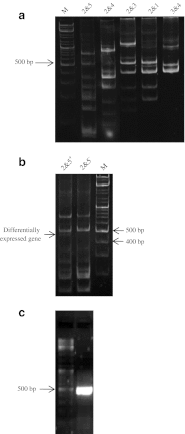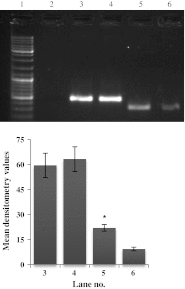Effect of nitrate availability on expression of multi sensor histidine kinase gene in Spirulina platensis PCC 7345
- PMID: 23573015
- PMCID: PMC3550582
- DOI: 10.1007/s12298-011-0076-4
Effect of nitrate availability on expression of multi sensor histidine kinase gene in Spirulina platensis PCC 7345
Abstract
Addition of nitrate (NO3 (-)) to a suspension of NO3 (-)-depleted Spirulina platensis PCC 7345 restored back the PSII reaction centre efficiency. Using RAPD/RT-PCR differential display, we have detected the upregulation of a novel gene in filaments starved of nitrogen when enriched with NO3 (-). Semiquantitative RT-PCR clearly shows that NO3 (-) repletion induces the expression of this gene. Its nucleotide sequence is homologous to multi sensor histidine kinase (hstk) from Spirulina platensis NIES-39 and Spirulina maxima CS-328 genes. The open reading frame of this gene encodes a protein of 98 amino acids contains sensory domain of PAS domain.
Keywords: Differential display; Histidine kinase; PSII reaction centre efficiency; Spirulina.
Figures




Similar articles
-
Differential response of photosynthetic apparatus towards alkaline pH treatment in NIES-39 and PCC 7345 strains of Arthrospira platensis.Int Microbiol. 2021 May;24(2):219-231. doi: 10.1007/s10123-021-00160-6. Epub 2021 Jan 12. Int Microbiol. 2021. PMID: 33438119
-
Identification of a gene regulated by HetR, a master regulator of heterocyst differentiation, in the non-heterocyst-forming filamentous cyanobacterium Arthrospira platensis NIES-39.J Gen Appl Microbiol. 2020 Jun 17;66(2):93-98. doi: 10.2323/jgam.2019.10.002. Epub 2019 Dec 17. J Gen Appl Microbiol. 2020. PMID: 31852855
-
Ammonium nitrate and iron nutrition effects on some nitrogen assimilation enzymes and metabolites in Spirulina platensis.Biotechnol Appl Biochem. 2015 Mar-Apr;62(2):275-86. doi: 10.1002/bab.1268. Epub 2014 Nov 25. Biotechnol Appl Biochem. 2015. PMID: 25425155
-
Methyladeninylcobamide functions as the cofactor of methionine synthase in a Cyanobacterium, Spirulina platensis NIES-39.FEBS Lett. 2010 Jul 16;584(14):3223-6. doi: 10.1016/j.febslet.2010.06.013. Epub 2010 Jun 17. FEBS Lett. 2010. PMID: 20558164
-
[Microalgae Spirulina in human nutrition].Vopr Pitan. 2004;73(1):45-53. Vopr Pitan. 2004. PMID: 15049159 Review. Russian.
References
-
- Aldehni MF, Sauer J, Spielhaupter C, Schmid R, Forchhammer K. Signal transduction protein PII is required for NtcA-regulated gene expression during nitrogen deprivation in the cyanobacterium Synechococcus elongatus strain PCC 7942. J Bacteriol. 2003;185:2582–2591. doi: 10.1128/JB.185.8.2582-2591.2003. - DOI - PMC - PubMed
-
- Allen MM, Smith AJ. Nitrogen chlorosis in blue-green algae. Arch Microbiol. 1969;69:114–120. - PubMed
-
- Allen MM, Law A, Evans EH. Control of photosynthesis during nitrogen depletion and recovery in a non-nitrogen-fixing cyanobacterium. Arch Microbiol. 1990;153:428–431. doi: 10.1007/BF00248422. - DOI
-
- Arnon DI. The discovery of photosynthetic phosphorylation. Trends Biochem Sci. 1984;9:258–262. doi: 10.1016/0968-0004(84)90159-2. - DOI
LinkOut - more resources
Full Text Sources
